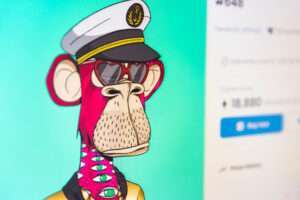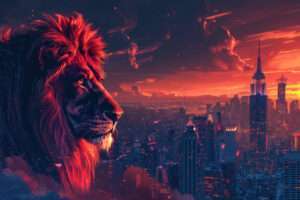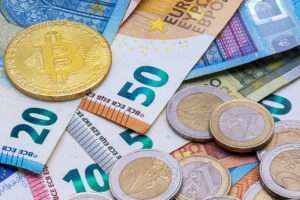NFTs, short for Non-Fungible Tokens, are distinctive digital assets logged onto the Blockchain.
Their uniqueness and immutability make them highly secure, guarding against theft and fraud. In 2021, NFTs earned the title of “word of the year” by Collins Dictionary. Steven Schuchart, GlobalData’s chief analyst, highlighted NFTs as a form of social currency emerging from the desire to utilize Blockchain beyond Cryptocurrencies.
The appeal of NFTs lies in their one-of-a-kind nature and security, representing several items like digital art, music, videos and in-game assets. Because NFTs cannot be replicated or modified, they ensure that creators and buyers maintain rightful ownership.
The Ascent of NFTs from Niche Interest to Widespread Craze
NFT history traces back to 2014 when Kevin McCoy minted the first NFT, “Quantum,” on the Namecoin Blockchain. Yet, it wasn’t until 2018 to 2021 that the industry attracted much attention. The market ballooned by 60 times, driven by the interest of youthful, affluent celebrities, influencers, and artists in the emerging scene.
Also, in March 2021, artist Mike Winkelmann, also known as Beeple, fetched a record-breaking $69 million for his NFT piece “Everyday” at Christie’s auction house, thrusting NFTs into the mainstream spotlight.
According to nonfungible.com, the NFT market exploded in 2021, with sales soaring to $17.6 billion (£13.9 billion), a whopping 21,000% surge from $82 million (£64.9 million) in 2020.
This spike was propelled by factors like:
- The rise in cryptocurrency prices generated capital for speculative investment in emerging digital assets.
- Esteemed artists and celebrities endorsing and launching NFTs.
- Major auction houses and galleries recognizing NFTs as a legitimate art form.
- Social media influencers promoting NFTs to retail investors.
- User-friendly NFT marketplaces, even for those unfamiliar with technology.
In the following months, Beeple’s groundbreaking auction, NFT transactions skyrocketed from millions to billions monthly. “NFT” found its way into dictionaries, surpassing search volumes for “Cryptocurrency” and “Bitcoin.”
With household names like Nike, Gucci, and Tiffany stepping into the arena, NFTs seemed unstoppable. Come 2022, NFTs continued to dominate, reshaping the art landscape and minting overnight millionaires and “richest living artists.”
From Hype to Rationalization
It is typical to say it wasn’t always a bed of roses for NFTs, as the journey was not without its share of hurdles.
The global interest in the NFT ecosystem was evident through Google search volumes, surpassing those for ETH and the Metaverse, peaking at the close of 2021. Major brands and sports figures like Cristiano Ronaldo inked deals, while even Donald Trump expanded his NFT collection. This trend hinted at a better NFT rating in 2022. Only to think.
From 2021 to early 2022, NFTs appeared to be leading the digital space. However, in 2022, the NFT market faced an untimed downturn as a result of:
- Cryptocurrency price crashes: February 2022 saw Russia’s invasion of Ukraine triggered turmoil in global financial markets which resulted in a Cryptocurrency price plunge. NFTs were also impacted.
- Fraud and security risks in the NFT space: In early 2022, OpenSea, the largest NFT marketplace, admitted to insider trading, tarnishing the industry’s reputation. As if not enough, phishing attacks and scams in the NFT worsened the situation.
- Limited practical applications of NFTs: Despite their innovation, the real-world applications of NFTs were still being explored, primarily confined to art, gaming items, etc.
As a result, the third quarter of 2022 saw a 77% plunge in transaction value, with net losses reaching $450 million (£355 million) for the first time.
In 2023, signs of vitality emerged within the NFT market. The industry began adapting, with creators, platforms, and buyers adopting a more cautious and regulated approach. High-value corporations and brands continued to explore NFTs, expanding their applications beyond traditional realms. This resurgence underscored the market’s shift from initial zeal to a more mature phase, emphasizing the enduring potential of NFTs to innovate and reshape the digital landscape.
In the meantime, participants in the NFT space began learning from past experiences and implementing measures to enhance the market environment. Creators recognized the value of their content, platforms and markets began enforcing more strict regulations while investors exercised greater caution before committing funds.
Furthermore, high-value corporations continued to pivot toward NFTs, with renowned brands like the English Premier League, Louis Vuitton, Sony and McDonald’s joining. NFT applications also expanded into areas such as financial loans and air travel.
NFTs Pave the Way for Digital-Physical Integration in Advertising and Web3 Engagement
By the close of 2023, the NFT market was heating up once again, with major NFT brands venturing into physical stores, e-commerce and numerous well-known companies actively participating in the NFT space. Investment in developing AAA blockchain games was also looming. A sign that the establishment and expansion of NFT brands would serve as a significant driver for propelling the Web3 industry in 2024.
Sequentially, 2024 has a myriad of activities in the digital space, more so, NFTs. We anticipate a surge in NFT products characterized by their small-scale, diverse, affordable, highly accessible nature, seamlessly blending virtual and real elements.
Mapping the Future
The evolution of NFTs reflects the market’s transition from initial enthusiasm to a more mature stage. Despite encountering challenges, the potential of NFTs as an emerging technology remains intact. Future developments may usher in new opportunities as technological innovation expands, application scenarios diversify, and market participants reassess risks and values.
Amidst this evolving landscape, ChainUp has emerged as a prominent player in the NFT product space. Specializing in Blockchain technology solutions, ChainUp offers comprehensive services catering to the growing demand for NFTs. Their platform streamlines the creation, management and sale of NFTs, making it more accessible for creators and investors alike. By prioritizing user experience, security, and integration with existing blockchain ecosystems, ChainUp provides a robust foundation for the development and expansion of NFT markets.
Rather than fading away, the NFT debate ‘has shifted to the longer-term impact of Blockchain applications in the art market,’ according to a 2023 report by Art Basel.
While researchers from Dapp Gambl pointed out that 95% of NFTs have either lost value or remain unsold, the remaining 5% of NFTs have thrived, now worth circa $10 billion (£790 million).
Disclaimer: This article is provided for informational purposes only. It is not offered or intended to be used as legal, tax, investment, financial, or other advice.









